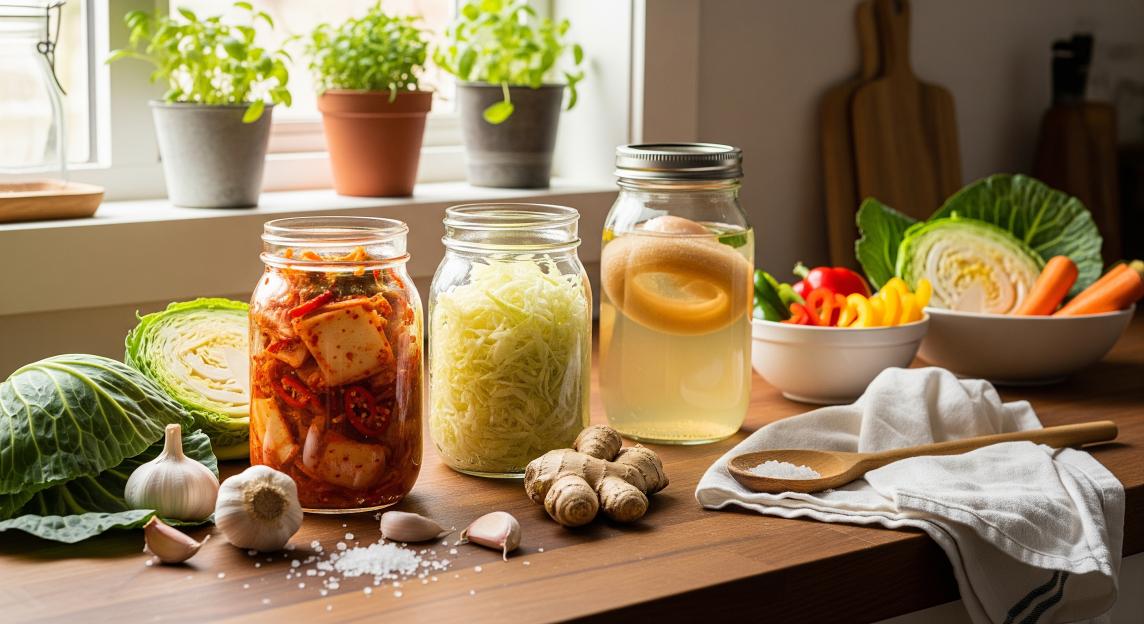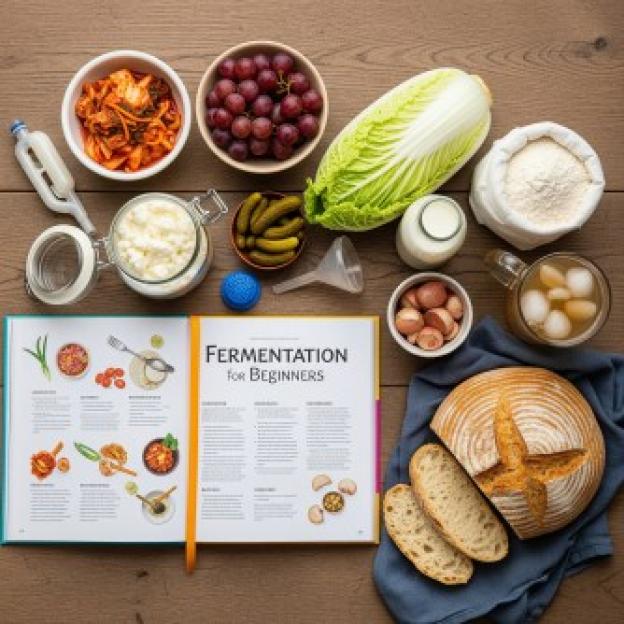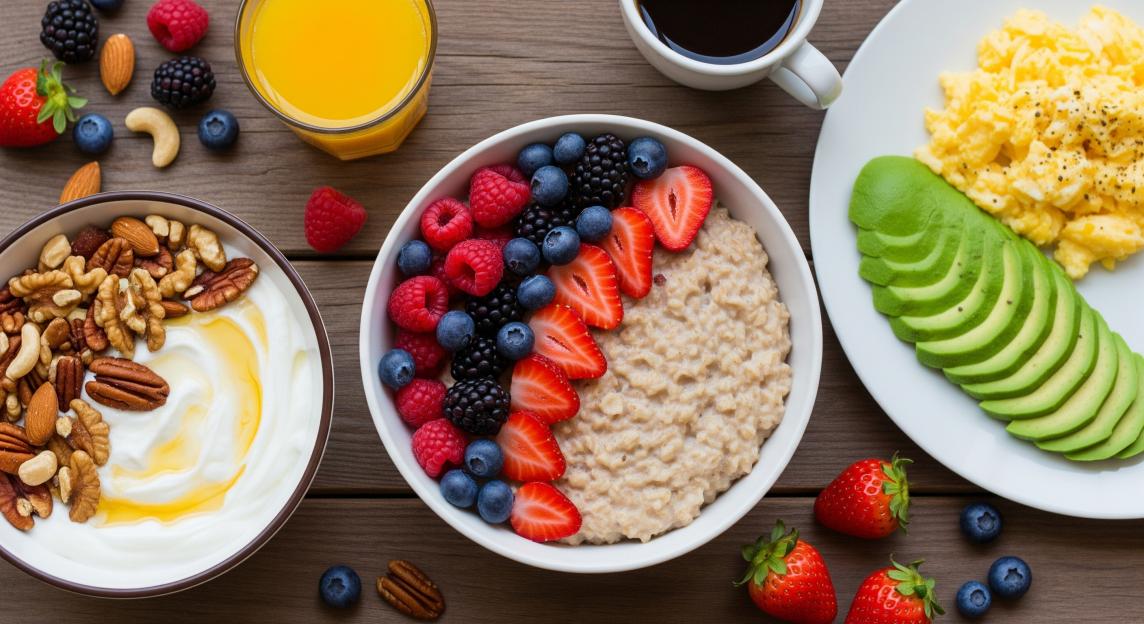The Ancient Magic Living in Your Kitchen
Picture this: millions of tiny workers quietly transforming ordinary ingredients into extraordinary superfoods right on your kitchen counter. No fancy equipment needed, no college degree required—just the same process that’s been nourishing humans for thousands of years. That satisfying tang in your morning yogurt, the complex flavors in aged cheese, even the bubbles in your favorite sourdough bread—they’re all gifts from the fascinating world of fermentation.
What Is Fermentation and Why Should You Care?
Fermentation is nature’s original food preservation method. When beneficial bacteria, yeasts, or other microorganisms break down sugars and starches in food, they create lactic acid, alcohol, or acetic acid. This process not only preserves food but also creates probiotics—live beneficial bacteria that support your digestive health.
The Science Made Simple
Think of fermentation as a controlled decomposition process. Good bacteria eat the sugars in your food and produce acids that:
- Preserve the food naturally
- Create beneficial probiotics
- Enhance nutrient absorption
- Develop unique flavors and textures
The beauty of fermented foods lies in their simplicity. Our ancestors didn’t know about probiotics or gut microbiomes, but they understood that fermented foods kept them healthy through long winters and difficult times.
Amazing Health Benefits of Fermented Foods

1. Digestive Health Revolution
Your gut contains trillions of bacteria—collectively called your gut microbiome. Fermented foods introduce beneficial bacteria that:
- Improve digestion: Help break down food more efficiently
- Reduce bloating: Balance gut bacteria to minimize digestive discomfort
- Enhance nutrient absorption: Make vitamins and minerals more bioavailable
- Support regular bowel movements: Promote healthy digestive transit
Research shows that people who regularly consume fermented foods have more diverse gut bacteria, which correlates with better overall health.
2. Immune System Support
Did you know that about 70% of your immune system lives in your gut? Fermented foods strengthen immunity by:
- Supporting beneficial bacteria that crowd out harmful pathogens
- Producing short-chain fatty acids that reduce inflammation
- Enhancing the gut barrier function
- Stimulating immune cell production
Studies indicate that people who eat fermented foods regularly experience fewer colds and infections.
3. Mental Health and Mood Benefits
The gut-brain connection is real. Your gut produces many of the same neurotransmitters found in your brain, including serotonin—the “happy hormone.” Fermented foods may help:
- Reduce anxiety and stress levels
- Improve mood and emotional well-being
- Support better sleep quality
- Enhance cognitive function
Research on the “psychobiotic” effects of fermented foods shows promising results for mental health support.
4. Heart Health and Cholesterol Management
Certain fermented foods contain compounds that support cardiovascular health:
- Kimchi and sauerkraut: Rich in antioxidants that reduce inflammation
- Kefir: Contains peptides that may help lower blood pressure
- Tempeh: Provides heart-healthy compounds that may reduce cholesterol
5. Blood Sugar Regulation
Fermented foods can help stabilize blood sugar levels through:
- Improved insulin sensitivity
- Slower carbohydrate absorption
- Better glucose metabolism
- Reduced post-meal blood sugar spikes
Essential Fermentation Equipment for Beginners
Basic Equipment You Already Have
Starting your fermentation journey doesn’t require expensive equipment. Most beginners can start with:
- Glass jars: Mason jars work perfectly for most projects
- Non-metal lids: Plastic lids or coffee filters with rubber bands
- Kitchen scale: For accurate measurements
- Clean kitchen towels: For covering fermenting foods
- Wooden spoons: For stirring (metal can interfere with fermentation)
Helpful Additions as You Progress
- Fermentation weights: Keep vegetables submerged in brine
- Airlock lids: Allow gases to escape while preventing contamination
- pH strips: Monitor acidity levels
- Fine-mesh strainer: For straining beverages like kombucha
Creating the Perfect Fermentation Environment
Temperature matters for successful fermentation. Most projects thrive at:
- Room temperature: 68-72°F (20-22°C)
- Consistent temperature: Avoid areas with temperature fluctuations
- Away from direct sunlight: Dark or dimly lit spaces work best
- Good air circulation: Prevent mold growth with proper ventilation
Easy Fermentation Recipes for Beginners
Recipe 1: Simple Sauerkraut
Ingredients:
- 2 pounds fresh cabbage
- 1 tablespoon sea salt (non-iodized)
Instructions:
- Prepare the cabbage: Remove outer leaves and core. Shred cabbage finely using a knife or food processor.
- Salt the cabbage: Place shredded cabbage in a large bowl. Sprinkle salt evenly and massage with clean hands for 5-10 minutes until liquid appears.
- Pack into jar: Transfer cabbage and its liquid to a clean quart-sized mason jar. Press down firmly to eliminate air bubbles. Liquid should cover cabbage completely.
- Weigh down: Place a clean weight (like a smaller jar filled with water) on top to keep cabbage submerged.
- Cover and ferment: Cover with a coffee filter secured with a rubber band. Ferment at room temperature for 3-4 weeks.
- Taste and store: Start tasting after one week. When you like the flavor, transfer to the refrigerator.
Troubleshooting Tips:
- White film on top is kahm yeast—harmless but scoop it off
- If cabbage browns, it’s getting too much air exposure
- Trust your senses—if it smells or looks bad, start over
Recipe 2: Beginner’s Kimchi
Ingredients:
- 2 pounds napa cabbage
- 1/4 cup sea salt
- 1 tablespoon grated ginger
- 4 garlic cloves, minced
- 1 teaspoon sugar
- 3 tablespoons fish sauce (or soy sauce for vegetarian)
- 1-3 teaspoons Korean red pepper flakes (gochugaru)
- 4 green onions, chopped
Instructions:
- Salt the cabbage: Cut cabbage into 2-inch pieces. Dissolve salt in 8 cups water. Soak cabbage for 2 hours, then rinse and drain thoroughly.
- Make paste: Combine ginger, garlic, sugar, fish sauce, and red pepper flakes into a paste.
- Mix: Combine drained cabbage with paste and green onions. Mix well with clean hands.
- Pack and ferment: Pack into jars, leaving 1 inch headspace. Weigh down and cover. Ferment 3-5 days at room temperature.
- Refrigerate: Once you achieve desired tanginess, refrigerate to slow fermentation.
Flavor Variations:
- Add julienned carrots or radishes
- Include Asian pear for sweetness
- Experiment with different vegetables like cucumber or bok choy
Recipe 3: Homemade Kombucha
Ingredients:
- 1 SCOBY (Symbiotic Culture of Bacteria and Yeast)
- 1/2 cup kombucha from previous batch
- 8 cups water
- 4 tea bags (black or green tea)
- 1/2 cup sugar
Instructions:
- Brew sweet tea: Boil water, steep tea bags for 10 minutes, stir in sugar until dissolved. Cool completely.
- Add SCOBY: Pour cooled tea into a wide-mouth jar. Add SCOBY and starter kombucha.
- Cover and ferment: Cover with coffee filter and rubber band. Ferment 7-10 days at room temperature.
- Taste test: Start tasting after 5 days. When you like the balance of sweet and tart, it’s ready.
- Second fermentation (optional): Reserve SCOBY and 2 cups kombucha for next batch. Bottle remaining kombucha with fruit or herbs for flavoring. Ferment 2-3 more days.
Flavoring Ideas for Second Fermentation:
- Ginger and lemon
- Berry medley
- Lavender and honey
- Pineapple and jalapeño
Recipe 4: Fermented Salsa
Ingredients:
- 4 large tomatoes, diced
- 1 onion, finely chopped
- 2 jalapeños, minced (remove seeds for milder salsa)
- 3 garlic cloves, minced
- 1/4 cup fresh cilantro, chopped
- 2 tablespoons lime juice
- 1 teaspoon sea salt
Instructions:
- Combine ingredients: Mix all ingredients in a bowl. Let sit 15 minutes for salt to draw out juices.
- Pack into jar: Transfer to mason jar, pressing down to eliminate air bubbles. Ensure vegetables are covered by their liquid.
- Ferment: Cover with coffee filter and ferment 2-3 days at room temperature.
- Refrigerate: Once fermented to taste, refrigerate and enjoy within 2 weeks.
Recipe 5: Water Kefir
Ingredients:
- 1/4 cup water kefir grains
- 4 cups filtered water
- 1/4 cup sugar
- 1/4 teaspoon sea salt
- 1/4 cup lemon juice
Instructions:
- Dissolve sugar: Mix sugar and salt in filtered water until dissolved.
- Add grains: Add water kefir grains and lemon juice to sugar water.
- Ferment: Cover and ferment 24-48 hours at room temperature.
- Strain: Strain out grains (save for next batch) and bottle the liquid.
- Second fermentation: Add fruit or herbs to bottles and ferment 1-2 more days for carbonation.
Common Fermentation Mistakes and How to Avoid Them
Mistake 1: Using the Wrong Salt
Problem: Iodized table salt contains additives that can interfere with fermentation. Solution: Use sea salt, kosher salt, or other non-iodized salts.
Mistake 2: Not Keeping Vegetables Submerged
Problem: Vegetables exposed to air can develop mold or unwanted bacteria. Solution: Always keep vegetables below the brine line using weights or proper packing techniques.
Mistake 3: Using Dirty Equipment
Problem: Contamination from unclean tools can ruin your ferment. Solution: Sanitize all equipment with hot water or food-grade sanitizer before use.
Mistake 4: Wrong Temperature
Problem: Too hot speeds fermentation uncontrollably; too cold slows it dramatically. Solution: Maintain consistent room temperature (68-72°F) for most projects.
Mistake 5: Not Being Patient
Problem: Opening jars frequently or rushing the process. Solution: Trust the process and resist the urge to constantly check your ferments.
Food Safety in Fermentation
Understanding pH and Acidity
Fermentation naturally creates an acidic environment that prevents harmful bacteria growth. Safe fermented foods typically have:
- pH below 4.6: This acidic environment inhibits dangerous pathogens
- Proper salt concentration: Usually 2-3% by weight for vegetables
- Anaerobic conditions: Oxygen-free environment prevents spoilage
Signs of Successful Fermentation
Good indicators:
- Pleasant sour or tangy smell
- Bubbling or fizzing sounds
- Vegetables remain crisp and colorful
- Cloudy brine (normal in vegetable ferments)
Warning signs:
- Foul, putrid odors
- Fuzzy mold growth (especially black, blue, or pink)
- Slimy texture
- Off-putting appearance
When in Doubt, Throw It Out
Trust your senses. If something looks, smells, or tastes off, it’s better to start over than risk illness.
Different Types of Fermentation
Lactic Acid Fermentation
This is the most common type for beginners, used in:
- Sauerkraut and kimchi
- Pickled vegetables
- Yogurt and kefir
- Sourdough starter
How it works: Lactobacillus bacteria convert sugars into lactic acid, creating the characteristic sour flavor and preserving the food.
Alcoholic Fermentation
Used in:
- Kombucha (low alcohol content)
- Wine and beer
- Water kefir
How it works: Yeasts convert sugars into alcohol and carbon dioxide.
Acetic Acid Fermentation
Used in:
- Vinegar production
- Some kombuchas in later stages
How it works: Acetobacter bacteria convert alcohol into acetic acid.
Wild Fermentation vs. Controlled Fermentation
Wild fermentation: Relies on naturally present microorganisms (like sauerkraut) Controlled fermentation: Uses specific starter cultures (like yogurt or kombucha with SCOBY)
Both methods can be safe and effective when proper techniques are followed.
Building Your Fermentation Practice
Start Small and Simple
Begin with one or two simple projects like sauerkraut or fermented salsa. Master these before moving to more complex ferments like kombucha or cheese.
Keep a Fermentation Journal
Track:
- Recipes and ingredient ratios
- Fermentation times and temperatures
- Taste preferences
- What worked and what didn’t
Join the Community
Connect with other fermentation enthusiasts through:
- Local fermentation clubs
- Online forums and social media groups
- Workshops and classes
- Farmers markets where vendors often share tips
Seasonal Fermentation
Take advantage of seasonal produce:
- Spring: Asparagus, radishes, spring onions
- Summer: Tomatoes, cucumbers, berries
- Fall: Cabbage, apples, root vegetables
- Winter: Preserved summer ferments, citrus
Advanced Techniques for the Curious
Creating Your Own Starter Cultures
Once comfortable with basic fermentation, you can:
- Cultivate wild yeast for sourdough
- Develop vegetable-specific lacto-bacteria cultures
- Experiment with different strains for unique flavors
Flavor Development Techniques
- Aging: Longer fermentation develops complex flavors
- Blending: Combine different fermented vegetables
- Spice integration: Add spices at different fermentation stages
- Temperature manipulation: Varying temperatures creates different flavor profiles
Troubleshooting Advanced Issues
- Managing pH levels for specific outcomes
- Dealing with surface blooms and kahm yeast
- Adjusting salt ratios for different vegetables
- Understanding fermentation timelines for various foods
The Global Journey of Fermented Foods
Traditional Fermented Foods Around the World
Fermentation isn’t just a health trend—it’s a global tradition:
Asia:
- Miso and tempeh: Fermented soy products packed with umami
- Kimchi: Korea’s national dish with complex spice profiles
- Pickled vegetables: Found in every Asian cuisine
Europe:
- Sauerkraut: German fermented cabbage tradition
- Kefir: Originated in the Caucasus mountains
- Cheese: Thousands of varieties from different regions
Americas:
- Fermented corn: Traditional in many indigenous cultures
- Chocolate: Cacao beans are fermented before processing
- Hot sauces: Many traditional recipes use fermentation
Africa:
- Injera: Ethiopian fermented teff bread
- Biltong: Traditional fermented meat preservation
- Various fermented grains: Staples across the continent
Learning from Traditional Methods
Traditional fermentation methods offer insights into:
- Natural preservation without refrigeration
- Maximizing nutrition from simple ingredients
- Creating complex flavors with minimal resources
- Building community around food preparation
Economic and Environmental Benefits
Cost Savings
Fermentation helps you:
- Preserve seasonal abundance
- Reduce food waste
- Create gourmet flavors at home
- Extend the life of fresh produce
Environmental Impact
Home fermentation:
- Reduces packaging waste from store-bought fermented foods
- Utilizes local, seasonal ingredients
- Requires minimal energy (no cooking or refrigeration during fermentation)
- Supports sustainable food practices
Building Food Security
Learning fermentation skills:
- Provides food preservation knowledge
- Reduces dependence on processed foods
- Creates emergency food supplies
- Connects you with traditional foodways
Integrating Fermented Foods into Your Daily Diet
Morning Routine
- Add kefir to smoothies
- Include fermented vegetables with breakfast
- Use kombucha as a morning beverage
- Try fermented oatmeal or yogurt parfaits
Lunch and Dinner Ideas
- Use sauerkraut as a sandwich topping
- Add kimchi to stir-fries and rice bowls
- Incorporate fermented salsas into Mexican dishes
- Serve fermented pickles as appetizers
Snack Options
- Fermented vegetable sticks
- Kombucha as an afternoon refresher
- Kefir-based dips
- Fermented fruit chutneys
Recipe Modifications
Transform regular recipes by:
- Replacing regular cabbage with sauerkraut in slaws
- Using fermented vegetables in salads
- Adding kombucha to salad dressings
- Incorporating fermented ingredients into sauces
Conclusion: Your Fermentation Journey Starts Now
Fermentation is more than just a cooking technique—it’s a gateway to better health, deeper connection with your food, and participation in an ancient tradition that spans cultures and continents. The benefits extend far beyond the tangy flavors and satisfying crunch of your homemade sauerkraut.
As you embark on this journey, remember that every expert was once a beginner. Your first batch might not turn out perfectly, and that’s completely normal. Each attempt teaches you something new about the fascinating world of beneficial bacteria and their incredible ability to transform simple ingredients into nutritional powerhouses.
The beauty of fermentation lies in its accessibility. You don’t need expensive equipment, specialized training, or perfect conditions. You need curiosity, patience, and willingness to trust the process that has nourished humans for millennia.
Start with one simple recipe—perhaps the basic sauerkraut or fermented salsa. Pay attention to the changes happening in your jar: the bubbling sounds, the developing aroma, the way vegetables transform from raw to deliciously tangy. These observations will build your confidence and understanding for more complex projects.
Remember that fermentation is as much about the journey as the destination. Each batch you create connects you to countless generations who have relied on these techniques for nutrition, preservation, and healing. You’re not just making food—you’re participating in living history while investing in your future health.
Your gut will thank you, your taste buds will celebrate, and you’ll gain the satisfaction of creating something truly beneficial with your own hands. Welcome to the wonderful world of fermentation—where ancient wisdom meets modern wellness, one delicious batch at a time.






